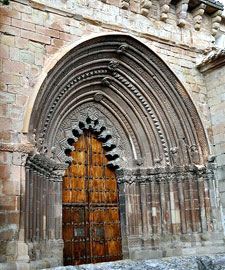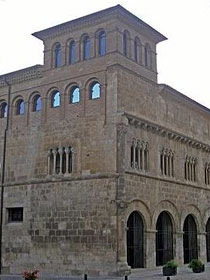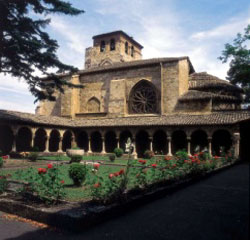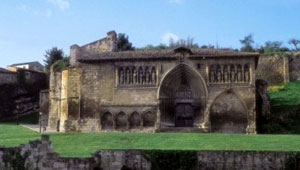Camino de Santiago - French Way - Stage 5 - Puente la Reina to Estella
Total distance: 22 kilometres
Walking down the Calle Mayor you will reach the medieval bridge over the river Arga and the route out of Puente la Reina. Turning left and following the road you will walk past the Convento Comendadores del Espíritu Santo and the Barrio de las Monjas. After about 100 metres you will come to a metal cross with a scallop shell, at this point you will need to turn left down a dirt track.
This track follows the flow of the River Arga and after about a kilometre you will pass a factory to your right. The track here begins to go uphill and it is here you wave goodbye to the River Arga. The track continues through fields and past the remains of the 13th Century Monasterio de Bargota and after having walked around 5 kilometres you reach the town of Mañeru.
As you enter the town you come across a medieval cruceiro or cross. Here you will find a private hostel, a couple of shops and café bars as well as a chemist. The town contains some remarkable houses with stone balconies and impressive family crests on their facades as well a neo-classical 18th century church called la Iglesia de San Pedro.
Leaving the village the path takes you through some olive groves and vineyards and past a cemetery. After about 2.5 kilometres you pass through a gothic arch into the medieval hilltop village of Cirauquí. A little unusually the Camino passes through a building where you can stamp your own credencial.

The 12th century Iglesia de San Román has an impressive doorway which is mainly Romanesque but also shows Cistercian influences.
There is an Albergue here which can be booked in advance and which serves both dinner and breakfast.
Leaving through one of the gothic arches the Camino takes a downhill track which leads to an old paved Roman road considered to be one of the best preserved examples along the Camino.
After crossing a rather dilapidated Roman bridge the route meanders through rolling yet arid hills. Every now and then the Roman road disappears only to reappear again. After nearly 5 kilometres you will cross the medieval bridge over the Rio Salado (salt river). In Aymeric Picaud's 12th century guidebook the writer warns the pilgrim:
"Beware of drinking from it or watering your horse in it, for this river brings death".
Once over the bridge you will pass through a tunnel under the road and down an asphalted road with the village of Lorca ahead. There are a couple of private hostels here that offer accommodation and a Pilgrim menu. Both hostels have cafés but there are also some vending machines as you leave the village.Leave the village passing the church and travelling down the main street. Turn left onto the N111 but then take the left down a track that winds through fields adjacent to this main road. After 5 kilometres you will come to another tunnel under the N111 and a Roman bridge which crosses the river and leads to the village of Villatuerta where you will find a couple of bars and a chemist as well as a recently renovated Albergue. At the top of the hill you will find the gothic 12th century Iglesia de la Asuncíon, an ideal place to rest a while.
Leave Villatuerta by following the tarmac road called Camino de Estella and after a short while you will come across the track that takes you past what remains of the Ermita de San Miguel. Continue along the path, passing the picnic area, and across the small footbridge over a stream and after approximately 4 kilometres you will pass the Iglesia del Espiritu Santo and the church of Santo Domingo. Pass through the tunnel under the road and enter the town of Estella.
Estella is another town that came into existence because of the large number of Pilgrims that followed the Camino de Santiago in the middle ages. A romantic place it has a number of palaces, stately homes, churches and beautiful buildings which earned it the name "Toledo of the North".

In his Pilgrim guide, Aymeric Picaud said "Estella is a city of good bread, excellent wine, much meat and fish and all kinds of pleasures."
The town was founded by King Sancho Ramírez in 1090 and one of the most impressive buildings in the town, the Palacio de los Reyes de Navarra built in the early 12th century, is considered a rare example of a civic Romanesque building, one of only a few remaining non-religious buildings from this era.

If you are a fan of architecture, and you still have a little energy after your trek, this town is a little piece of heaven as there are so many buildings worth seeing including two 18th century palaces surrounding the Plaza de los Fueros. There is also the 16th century Eguía Palace, the 17th century Governor's Palace and the house of Fray Diego de Estella, a 16th century stately home to name but a few.
If you are interested in religious buildings there are the ruins of the medieval church Iglesia de San Pedro de Lizarra. Alternatively, there is the Iglesia de San Pedro de la Rúa with its 12th century cloister or the 14th century Iglesia del Santo Sepulcro as well as a number of others.
The Iglesia del Santo Sepulcro in particular has a very interesting 16th century façade. Above the main door there are 3 rows of sculptures. The highest row of sculpture depicts the crucifixion, the next row depicts the 3 Mary's at the sepulchre (Mary of Cleopas, Mary Magdalene and Mary, the mother of James and John), the rescue of the innocents and when Mary Magdalene recognises Jesus following the crucifixion, the lowest row depicts the last supper. The door is also surrounded by the 12 apostles.
Most importantly after having walked so far you will want somewhere to eat and sleep. The town has 2 refugios and a few hostels as well as a number of restaurants, bars and cafés which are found over the Rio Ega.

